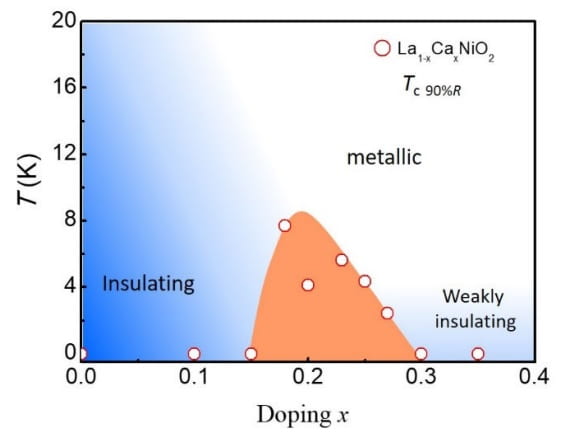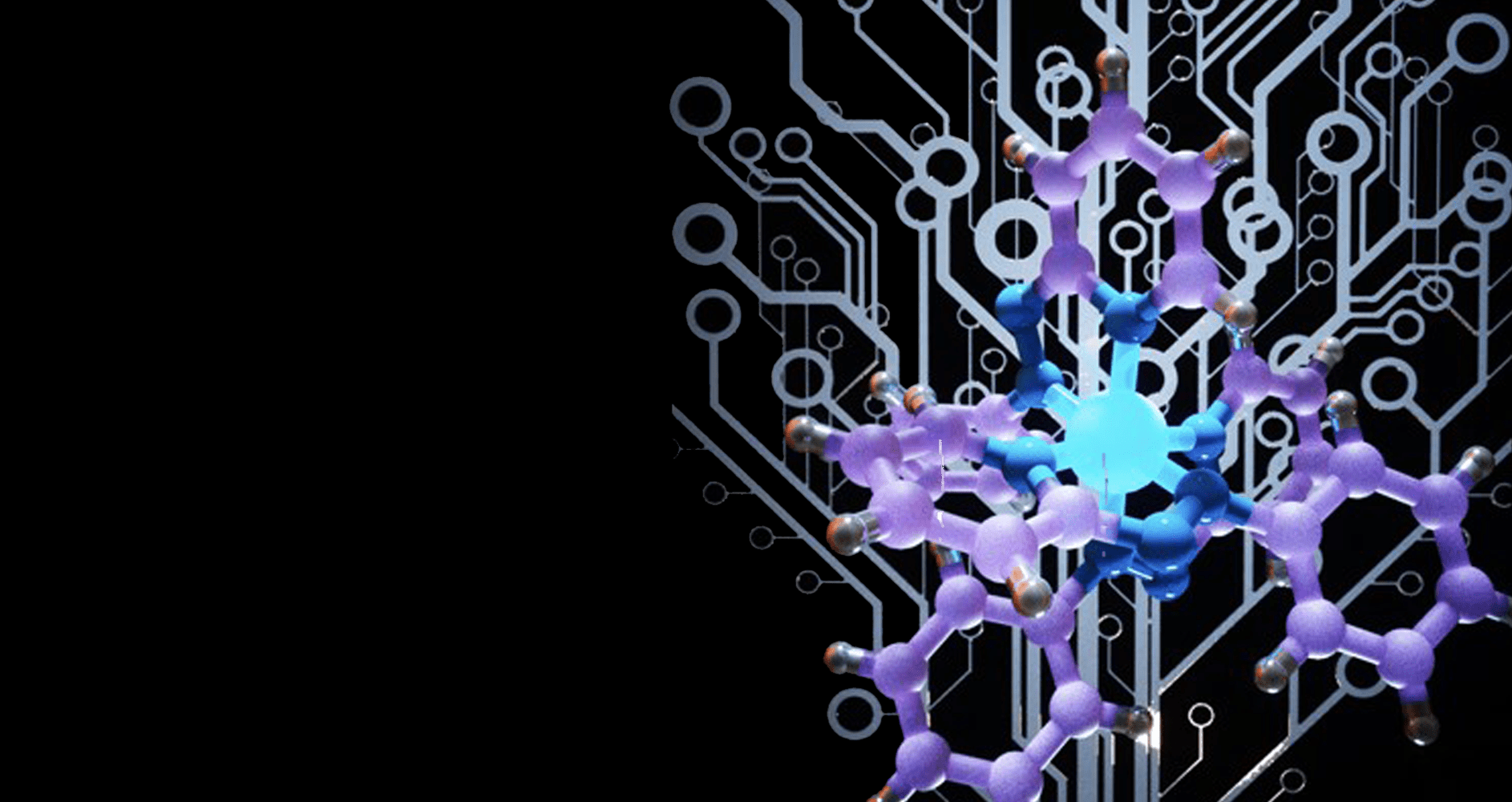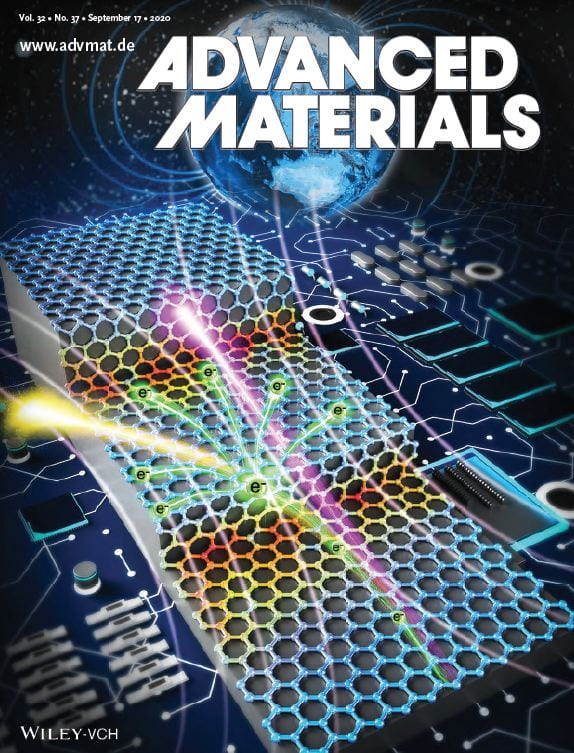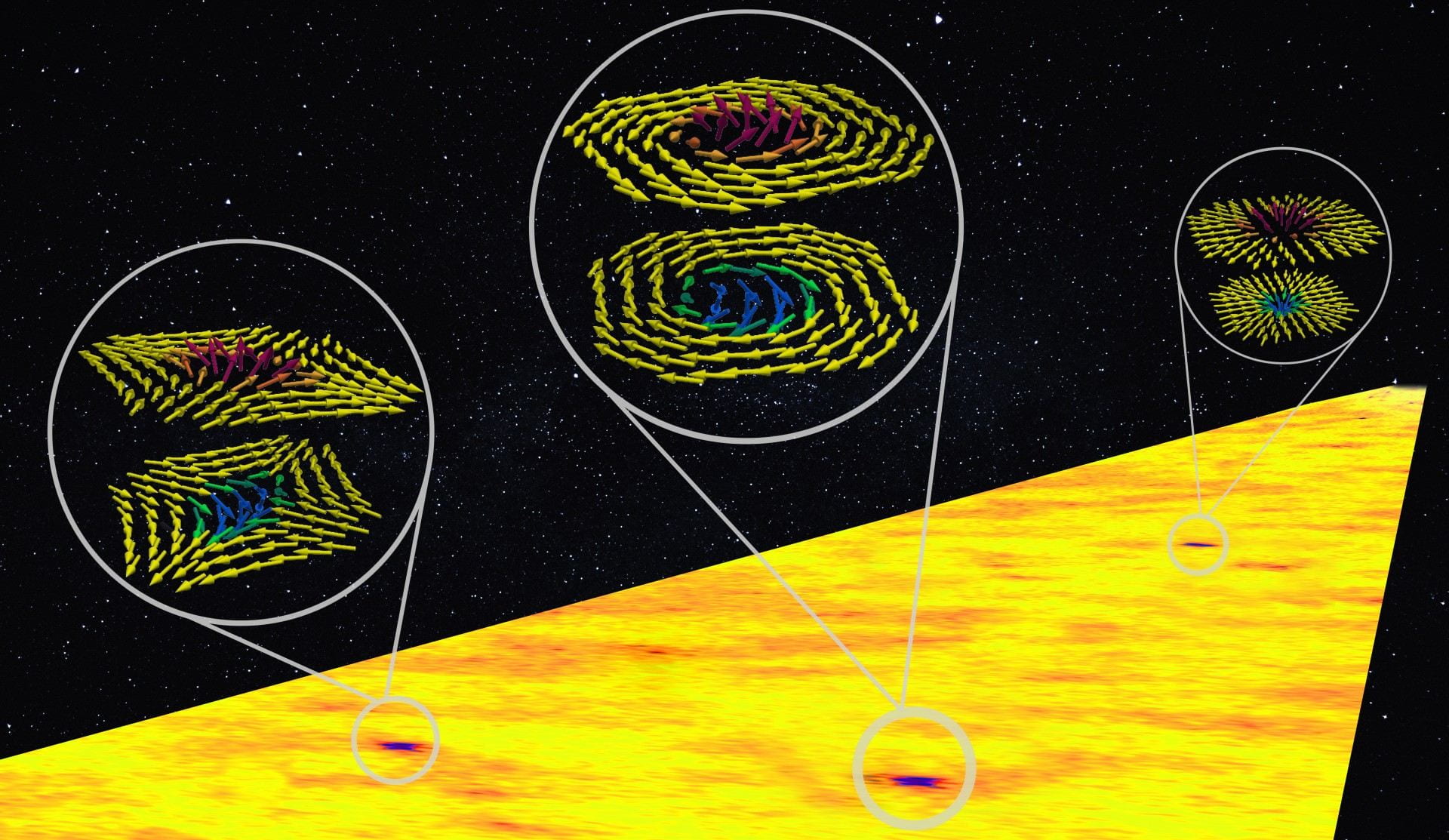Prof Ariando’s research focuses on the physics and devices of functional (quantum) materials, with an emphasis on the strongly correlated oxides. He won the Faulty of Science Outstanding Scientist Award in 2022 for his work on quantum interfaces and nickelates-based superconductivity, and continues to publish well in discovering other novel materials and properties.
Origin of a Topotactic Reduction Effect for Superconductivity in Infinite-Layer Nickelates
[PHYSICAL REVIEW LETTERS 133, 066503 (2024) – Editors’ Suggestion]
A spectroscopic study of the infinite-layer Nd0.8Sr0.2NiO2 thin films unveils a singular Ni 3d orbital in an optimally reduced condition, highlighting the importance of topotactic reduction for achieving superconductivity.
Topotactic reduction is a unique soft chemistry process that removes the apical oxygen from the oxygen-metal octahedron, transforming transition metal oxides from a conventional perovskite structure to an infinite-layer structure. This process is believed to be a prerequisite for achieving superconductivity in the newly discovered infinite-layer nickelates. However, its effect on atomic reconstruction and electronic structures remains largely unresolved. Here, we report on ion mass spectrometry and X-ray absorption spectroscopy measurements of infinite-layer Nd0.8Sr0.2NiO2 thin films with varying levels of topotactic reduction. Contrary to previous beliefs, we found that reduction-induced hydrogen intercalation is negligible in the pure infinite-layer phase and is not critical to superconductivity. Instead, we observed a singular Ni 3d orbital in the optimally reduced state and orbital mixing in both the under-reduced and over-reduced states. Our findings reveal the critical role of reduction in modulating the Ni 3d orbital polarization and its impact on the superconducting properties, providing new insights into the mechanisms of superconductivity in infinite-layer nickelates.
Towards improving future electronic devices through oxide materials
[Phys. Rev. Lett. 129, 187203 (2022)] National University of Singapore (NUS) physicists have demonstrated a new way of controlling Rashba interactions in oxide systems. This method for tuning and controlling Rashba interactions is particularly promising as it can potentially be integrated directly into functional logic and memory devices.
Scientists and engineers need devices that can process information efficiently while having ultra-low power consumption. Recently, there have been new developments in logic and memory devices that use the spin of electrons, in addition to their electronic charge, to store and process information. To make it work well, the device architecture needs a strong interaction between the spin of electrons and their orbital moments. This coupling, known as Rashba effect, allows for easy manipulation of spin currents and can lead to lower energy consumption. In particular, it can facilitate voltage-driven magnetization switching for logic and memory computing with reduced energy consumption, as proposed by Intel®*. However, to be useful in this regard, this effect must be significantly large even at zero applied voltages, which has remained difficult to realize in traditional semiconducting and metallic systems.
The research team led by Professor Ariando from the NUS Department of Physics demonstrated that lattice polarisation and the trapping of interfacial charge carriers can result in a large Rashba spin-orbit effect at the oxide material interface in the absence of an external bias. This finding was published in Physical Review Letters.
Oxide systems have great potential for exploiting the Rashba effect because their multiple degrees of freedom (charge, spin, orbital, and lattice) are entangled with one another. Under Prof Ariando’s guidance and with the support of the research team, Dr Ganesh Ji Omar, the lead author of the paper, came up with a new and different methodology for controlling the Rashba effect in oxide material systems.
In their experiments, the researchers developed two-dimensional electron gas (2DEG) at LaAlO3-SrTiO3 interfaces and buffered by a LaFeO3 carrier modulating layer. All individual oxide layers during the fabrication process were controlled in real time and the resulting structures were validated using high-resolution electron microscopy. This heterostructure led to significant enhancement of Rashba effect at the correlated LaAlO3-SrTiO3 interfaces even when no external voltage was applied. This remarkable enhancement effect was explained using a framework of “orbital hybridization of interfacial electronic wave functions” at oxide interfaces. The theoretical research team further validated this unconventional Rashba effect using density functional theory.
Prof Ariando said, “This work highlights the fundamental role of lattice polarisation in achieving the observed enhancement of Rashba spin-orbit coupling and is particularly promising for efficient spin-to-charge conversion. Moreover, it can lead to the discovery of various other exotic properties, such as spiral magnetism, topological superconductivity, and intrinsic spin Hall effect.”
Novel ferroelectric material for the future of data storage solutions
Since its discovery more than 100 years ago, ferroelectric materials still garner much attention in research due to their wide-ranging applications, from data storage to renewable energy systems. Ferroelectric materials can generate an electric field and offer several benefits, such as high writing speed for data storage, high storage density, lower operating power, and the ability to retain data without a power source.
Two-dimensional (2D) ferroelectric materials are an emerging type of ferroelectric material. However, research and development in this area is limited due to the small number of available materials.
Adding to the current library of 2D ferroelectric materials, physicists from NUS have recently discovered a new single-element material, known as 2D black phosphorus-like bismuth (BP-Bi), that demonstrates ferroelectric properties. This new material changes the conventional understanding of ferroelectric materials, which are commonly made up of compounds – more than one element – with opposing charges to allow the formation of an electric field. This finding solves the fundamental question of whether single-element substances have ferroelectric properties.
This ground-breaking discovery was achieved by a team led by Professor Andrew Wee from the Department of Physics under NUS Faculty of Science, with collaborators Professor Chen Lan from the Institute of Physics under the Chinese Academy of Sciences, and Professor Lu Yunhao from School of Physics under Zhejiang University. Findings of this novel ferroelectric material were published in Nature on 5 April 2023.
The researchers used cutting-edge techniques to visualise in detail the single-element material, BP-Bi, at an atomic scale. Through experimental methods, they observed a new form of ferroelectricity within the structure of BP-Bi, which an external source of electricity can control.
The researchers shared that this form of ferroelectricity will have implications for future quantum electronic devices and advanced data storage devices. This new single-element ferroelectric material also provides a fresh perspective to studying the basic physical properties of elements.
Prof Wee said, “In addition to overturning the common-sense idea that ionic polarisation only exists in compounds, we believe that single-element ferroelectricity in BP-Bi would introduce a new perspective to the study and design of novel ferroelectric materials, and inspire new physics of elemental materials in the future.
Discovery of superconductivity in infinite-layer lanthanide nickelates
[Science Advances 8, eabl9927 (2022)] The origin of high-Tc superconductivity remains an enigma even though tremendous research effort and progress have been made on cuprate and iron pnictide superconductors. Aiming to mimic the cuprate-like electronic configuration of transition metal, superconductivity has been recently found in nickelates. This discovery hallmarks a new era in the search and understanding of the high-Tc superconductivity. However, unlike the cuprate and iron pnictide, in which the superconductivity was initially found in a compound containing La, the superconductivity in the nickelate has only been observed in Nd- and Pr-based compounds. This raises a central question of whether the f electron of the rare-earth element is critical for superconductivity in the nickelates. Here, we report the observation of superconductivity in infinite-layer Ca-doped LaNiO2 (La1-xCaxNiO2) thin films and construct their phase diagram. Unlike the metal-insulator transition in Nd- and Pr-based nickelates, the undoped and underdoped La1-xCaxNiO2 thin films are entirely insulating from 300 down to 2 K. A superconducting dome is observed from 0.15<x<0.3 with weakly insulating behavior at the overdoped regime. Moreover, the sign of the Hall coefficient RH changes at low temperature for samples with a higher doping level. However, distinct from the Nd- and Pr-based nickelates, the RH-sign-change temperature remains around 35 K as the doping increases, suggesting a different multiband structure in the La1-xCaxNiO2. These results also emphasize the significant role of lattice correlation on the multiband structures of the infinite-layer nickelates.
NUS researchers develop brain-inspired memory device – Nature 597, 51 (2021)
NUS researchers develop brain-inspired memory device that can revolutionise semiconductor design
Reconfigurable device can simplify semiconductor circuit design and enhance computational power and speed
Many electronic devices today are dependent on semiconductor logic circuits based on switches hard-wired to perform predefined logic functions. Physicists from the National University of Singapore (NUS), together with an international team of researchers, have developed a novel molecular memristor, or an electronic memory device, that has exceptional memory reconfigurability.
Unlike hard-wired standard circuits, the molecular device can be reconfigured using voltage to embed different computational tasks. The energy-efficient new technology, which is capable of enhanced computational power and speed, can potentially be used in edge computing, as well as handheld devices and applications with limited power resource.
“This work is a significant breakthrough in our quest to design low-energy computing. The idea of using multiple switching in a single element draws inspiration from how the brain works and fundamentally reimagines the design strategy of a logic circuit,” said Associate Professor Ariando from the NUS Department of Physics who led the research.
The research was first published in the journal Nature on 1 September 2021, and carried out in collaboration with the Indian Association for the Cultivation of Science, Hewlett Packard Enterprise, the University of Limerick, the University of Oklahoma, and Texas A&M University.
Brain-inspired technology
“This new discovery can contribute to developments in edge computing as a sophisticated in-memory computing approach to overcome the von Neumann bottleneck, a delay in computational processing seen in many digital technologies due to the physical separation of memory storage from a device’s processor,” said Assoc Prof Ariando. The new molecular device also has the potential to contribute to designing next generation processing chips with enhanced computational power and speed.
“Similar to the flexibility and adaptability of connections in the human brain, our memory device can be reconfigured on the fly for different computational tasks by simply changing applied voltages. Furthermore, like how nerve cells can store memories, the same device can also retain information for future retrieval and processing,” said first author Dr Sreetosh Goswami, Research Fellow from the Department of Physics at NUS.
Research team member Dr Sreebrata Goswami, who was a Senior Research Scientist at NUS and previously Professor at the Indian Association for the Cultivation of Science, conceptualised and designed a molecular system belonging to the chemical family of phenyl azo pyridines that have a central metal atom bound to organic molecules called ligands. “These molecules are like electron sponges that can offer as many as six electron transfers resulting in five different molecular states. The interconnectivity between these states is the key behind the device’s reconfigurability,” explained Dr Sreebrata Goswami.
Dr Sreetosh Goswami created a tiny electrical circuit consisting a 40-nanometer layer of molecular film sandwiched between a top layer of gold, and a bottom layer of gold-infused nanodisc and indium tin oxide. He observed an unprecedented current-voltage profile upon applying a negative voltage to the device. Unlike conventional metal-oxide memristors that are switched on and off at only one fixed voltage, these organic molecular devices could switch between on-off states at several discrete sequential voltages.
Using an imaging technique called Raman spectroscopy, spectral signatures in the vibrational motion of the organic molecule were observed to explain the multiple transitions. Dr Sreebrata Goswami explained, “Sweeping the negative voltage triggered the ligands on the molecule to undergo a series of reduction, or electron-gaining which caused the molecule to transition between off and on states.”
The researchers described the behavior of the molecules using a decision tree algorithm with “if-then-else” statements, which is used in the coding of several computer programs, particularly digital games, as compared to the conventional approach of using basic physics-based equations.
New possibilities for energy-efficient devices
Building on their research, the team used the molecular memory devices to run programs for different real-world computational tasks. As a proof of concept, the team demonstrated that their technology could perform complex computations in a single step, and could be reprogrammed to perform another task in the next instant. An individual molecular memory device could perform the same computational functions as thousands of transistors, making the technology a more powerful and energy-efficient memory option.
“The technology might first be used in handheld devices, like cell phones and sensors, and other applications where power is limited,” added Assoc Prof Ariando.
The team in the midst of building new electronic devices incorporating their innovation, and working with collaborators to conduct simulation and benchmarking relating to existing technologies.
Other contributors to the research paper include Abhijeet Patra and Santi Prasad Rath from NUS, Rajib Pramanick from the Indian Association for the Cultivation of Science, Martin Foltin from Hewlett Packard Enterprise, Damien Thompson from the University of Limerick, T. Venkatesan from the University of Oklahoma, and R. Stanley Williams from Texas A&M University.
Press Release:
NUS Research News, 2 September 2021
NUS researchers develop brain-inspired memory device that can revolutionise semiconductor design
Coverage:
NUS Spokesperson Twitter, 2 September 2021
(copy https://twitter.com/NUSspokesperson/status/1433284285000138752 into web browser)
NUS Twitter, 3 September 2021
(copy https://twitter.com/NUSingapore/status/1433602420886499347 into web browser)
NUS Research Twitter, 3 September 2021
(copy https://twitter.com/NUSResearch/status/1433602647341207552 into web browser)
NUS Facebook, 3 September 2021
NUS LinkedIn, 3 September 2021
ZDNet, 2 September 2021
Singapore researchers develop ‘reconfigurable’ memory chip technology
Computer Weekly, 2 September 2021
NUS researchers develop brain-inspired memory device
Science Daily, 2 September 2021
Mirage News, 2 September 2021
Researchers develop brain-inspired memory device that can revolutionise semiconductor design
Techiai.com, 3 September 2021
Brain-inspired memory device: Reconfigurable device can simplify semiconductor circuit design and enhance computational power and speed
Memristors
Lack of uniformity is possibly the biggest challenge in today’s technology of memristor devices as it gives rise to problems like inconsistency, stochastic variability, and instability of the memory state. A uniform switching mechanism in memristors is something researchers have been looking in the last several decades.
Now, an international team, led by the scientists from the National University of Singapore (NUS), has developed a solution to address this long-standing problem in the field of organic and molecular electronics.
This work was published in the journal Advanced Materials on 6 September 2020.
Professor T. Venkatesan, who led this project, said, “We are working on an organic material system that is possibly one of the most efficient platforms for realising artificial intelligence and brain-inspired computing. My former graduate student Dr Sreetosh Goswami, who is now a postdoctoral researcher at the NUS Department of Physics, is the key architect of this work. While working on our previous studies on molecular memristors that were published in Nature Materials and Nature Nanotechnology, he discovered that the conductance switching is amazingly uniform.”
“A molecular switching mechanism should ideally be uniform. The fact that no one ever observed a uniform switching puts the credibility of organic memristors into question. What it says is that either the existing measurements are problematic, or the mechanism is non-molecular,” explained Dr Sreetosh.
In this paper, the team resolved the problem by demonstrating a homogeneous molecular switching with less than 7 nanometre spatial resolution. This work also provided guidance on how such measurements should be performed, and how ideal molecular switching should look like.
Dr Sreetosh added, “I thank Professor Venkatesan for sending me to France to collaborate with HORIBA on the tunnelling enhanced Raman Spectroscopy measurements. These measurements enabled characterisation at molecular levels, and what we showed here is a small part of the data we have acquired. Much more exciting results are on the way.”
The material systems used in this study is the brainchild of Professor Sreebrata Goswami, who is from the Indian Association for the Cultivation of Science, Kolkata. Professor Sreebrata shared, “The correlation we have observed between micro and nano-scale measurements in this study is just amazing. It shows the homogeneity and scalability of a molecular mechanism in a device. Through nano-Raman spectroscopy, we were able to monitor the individual bonds in a molecule as a function of voltage. Such deterministic understanding of molecular mechanism charts routes to design new molecular systems, and we are currently in progress of doing so.”
“While usual memristors show switching energy in the order of pico joule, these devices promise switches with energy dissipation in the range of atto joules. This is a huge advantage offered by the material system,” elaborated Associate Professor Ariando. He is a co-author of the paper, and also the lead Principal Investigator of the grant that supported this research.
This research was conducted in collaboration with HORIBA in France, and Professor Stanley Williams of Texas A&M University.
The NUS research team is currently using these molecular platforms to realise brain-inspired functionalities such as unsupervised learning, classification in addition to probabilistic computing.
“We believe this has the potential to revolutionise current technology by orders of magnitude in terms of energy cost,” said Prof Venkatesan.
Hybrid 2d material/functional oxides
Graphene is a typical two-dimensional (2D) material with various exceptional properties and can form a strong ambipolar 2D hole or electron conducting gas tunable by various external perturbations. Meanwhile, complex oxides have also shown various emergent physical properties resulting from the complex interplay between the electronic, orbital, spin and structural degrees of freedom. Novel properties might emerge when the graphene quantum system’s extraordinary properties are tuned by or coupled to the functional oxides.
In this article, we realized giant magnetoresistances in single-layer graphene of up to 5,000% (a world record for single-layer graphene) by inducing carrier fluctuation in graphene utilizing the terraced surface of the oxides. Not only this system serves as a playground for studying disordered induced magnetoresistance, but the large magnetoresistance effect in this pure two-dimensional system is also a high potential for nanoscale magnetic sensing.
Topological Magnetic Textures by Design
Magnetic Skyrmions are smoothly varying local spin arrangement of size ranging from 10 to 100 nm. From theoretical simulations, these quasiparticles are known to have several attractive properties. On the other hand, there are multiple degrees of freedom in magnetic oxides but absent in metallic ferromagnets, such as multiferroicity and magnetoelectric coupling that offer a way to control magnetism. Hence, stabilizing magnetic Skyrmion in oxides may prove advantageous. In the past, magnetic oxides are known to be majority antiferromagnetic and have few practical applications. In the recent years, however, the concept of antiferromagnetic spintronic begins receiving attention and appreciation because of the insensitivity of antiferromagnets to a stray magnetic field that would enhance the reliability of data storage devices.
In this work, we demonstrate that we can utilize charge transfer induced interface ferromagnetism as a robust tool to widen the accessible material choices where topologically protected spin textures, or magnetic Skyrmions, can be stabilized. We became the first to understand that Skyrmions can be stabilized by interfacial charge transfer between a paramagnet with strong spin-orbit coupling (SOC) exemplified by CaIrO3 and an antiferromagnet exemplified by CaMnO3. Such an effect is absent in individual bulk materials. This concept can potentially be generalized to many more antiferromagnetic-paramagnetic oxide combinations; hence Skyrmions with practical characteristics can be tailored, such as the occurrence at high temperature, low magnetic field, and small Skyrmion size for practical memory applications. We also hope to demonstrate magnetoelectric coupling in oxide Skyrmions in the future.
Discovery of Whirl – Nature 590, 74 (2021)
In the quest for post-CMOS (complementary metal–oxide–semiconductor) technologies, driven by the need for improved efficiency and performance, topologically protected ferromagnetic ‘whirls’ such as skyrmions and their anti-particles have shown great promise as solitonic information carriers in racetrack memory-in-logic or neuromorphic devices. However, the presence of dipolar fields in ferromagnets, which restricts the formation of ultrasmall topological textures, and the deleterious skyrmion Hall effect, when skyrmions are driven by spin torques, have thus far inhibited their practical implementation. Antiferromagnetic analogues, which are predicted to demonstrate relativistic dynamics, fast deflection-free motion and size scaling, have recently become the subject of intense focus, but they have yet to be experimentally demonstrated in natural antiferromagnetic systems. Here we realize a family of topological antiferromagnetic spin textures in α-Fe2O3—an Earth-abundant oxide insulator—capped with a platinum overlayer. By exploiting a first-order analogue of the Kibble–Zurek mechanism, we stabilize exotic merons and antimerons (half-skyrmions) and their pairs (bimerons), which can be erased by magnetic fields and regenerated by temperature cycling. These structures have characteristic sizes of the order of 100 nanometres and can be chemically controlled via precise tuning of the exchange and anisotropy, with pathways through which further scaling may be achieved. Driven by current-based spin torques from the heavy-metal overlayer, some of these antiferromagnetic textures could emerge as prime candidates for low-energy antiferromagnetic spintronics at room temperature.









